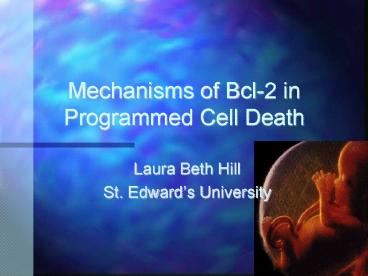Mechanisms of Bcl-2 in Programmed Cell Death PowerPoint PPT Presentation
1 / 20
Title: Mechanisms of Bcl-2 in Programmed Cell Death
1
Mechanisms of Bcl-2 in Programmed Cell Death
- Laura Beth Hill
- St. Edwards University
2
Apoptosis
- Essential for normal embryonic development
- Natural and pathological
- Morphologic characteristics
- Regulated by proteins in Bcl-2 family
3
(No Transcript)
4
(No Transcript)
5
The Apoptotic Process
- Cell receives death signal
- Mitochondrial membrane potential decreases
- Transport of cytochrome c through membrane into
cytosol - Cytochrome c binds to Apaf-1
- Caspase activity initiated
- Cell degradation
6
What is Bcl-2?
- Family of proteins that includes promoters and
inhibitors - Proto-oncogene
- Localized to outer mitochondrial membrane
- Can form homo- and heterodimers
- Exhibits biphasic expression
7
FOCUS OF SEMINARPossible Mechanisms
- Bcl-2 blocks release of cytochrome c from
mitochondrial membrane (Yang, et al.,
1997) - Bcl-2 forms channels in lipid membranes
(Schendel, et al., 1997)
8
Cytochrome c Model
- Necessary for the initiation of apoptosis
- Found in the mitochondrial intermembrane space
- Localization suggests connection between Bcl-2
and cytochrome c
9
HL-60 cells
neo cells
bcl-2 cells
Isolation
Isolation
Staurosporine
Staurosporine
Immunoblot analysis
Immunoblot analysis
10
Yangs Results
- Cytochrome c in neo cells showed cytosol
increase, with corresponding decrease in
mitochondria - No significant change of cytochrome c in
mitochondria or cytosol of Bcl-2 cells - No significant amount of cytochrome c found in
cytosol of control cells
11
Yangs Conclusion
- Bcl-2 prevents the release of cytochrome c
- Mechanism by which Bcl-2 blocks release unknown
- Structural similarity to bacterial toxins
suggests pore-forming ability
12
Channel Formation Model
- Bcl-2 can regulate ion fluxes and protein
translocation - 3D structure of Bcl-xL is similar to the
pore-forming domains of DT and the bacterial
colicins
13
Protein Production
Bcl-2 (?5,6) mutant
Bcl-2 wild-type
Cl- efflux assay
Cl- efflux assay
Detection of single channels
Detection of single channels
14
Schendels Results
- Bcl-2 formed ion-conducting pores in a manner
similar to that of bacterial toxins - Bcl-2 mutant produced only non-specific Cl-
efflux - Bcl-2 in planar lipid bilayers formed discrete
cation-selective channels - Bcl-2 mutant did not form channels here
15
(No Transcript)
16
Schendels Conclusions
- Biophysical evidence proves that Bcl-2 forms
channels in membranes - Channels reside in closed state
- What regulates channels?
- How do pro-apoptotic proteins oppose
anti-apoptotic proteins?
17
(No Transcript)
18
Practical Importance
- Association of disease with inappropriate
apoptosis - Adjustment of apoptotic threshold
- Gene therapy to control cell death
- Protection of developing nervous system against
neurotoxins (e.g. EtOH)
19
Acknowledgements
- St. Edwards School of Natural Sciences faculty
and staff
20
(No Transcript)

